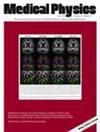The accuracy of proton therapy and preclinical proton irradiation experiments is susceptible to proton range uncertainties, which partly stem from the inaccurate conversion between CT numbers and relative stopping power (RSP). Proton computed tomography (PCT) can reduce these uncertainties by directly acquiring RSP maps.
This study aims to develop a novel PCT imaging system based on scintillator-based proton range detection for accurate RSP reconstruction.
The proposed PCT system consists of a pencil-beam brass collimator with a 1 mm aperture, an object stage capable of translation and 360° rotation, a plastic scintillator for dose-to-light conversion, and a complementary metal oxide semiconductor (CMOS) camera for light distribution acquisition. A calibration procedure based on Monte Carlo (MC) simulation was implemented to convert the obtained light ranges into water equivalent ranges. The water equivalent path lengths (WEPLs) of the imaged object were determined by calculating the differences in proton ranges obtained with and without the object in the beam path. To validate the WEPL calculation, measurements of WEPLs for eight tissue-equivalent inserts were conducted. PCT imaging was performed on a custom-designed phantom and a mouse, utilizing both 60 and 360 projections. The filtered back projection (FBP) algorithm was employed to reconstruct the RSP from WEPLs. Image quality was assessed based on the reconstructed RSP maps and compared to reference and simulation-based reconstructions.
The differences between the calibrated and reference ranges of 110–150 MeV proton beams were within 0.18 mm. The WEPLs of eight tissue-equivalent inserts were measured with accuracies better than 1%. Phantom experiments exhibited good agreement with reference and simulation-based reconstructions, demonstrating average RSP errors of 1.26%, 1.38%, and 0.38% for images reconstructed with 60 projections, 60 projections after penalized weighted least-squares algorithm denoising, and 360 projections, respectively. Mouse experiments provided clear observations of mouse contours and major tissue types. MC simulation estimated an imaging dose of 3.44 cGy for decent RSP reconstruction.
The proposed PCT imaging system enables RSP map acquisition with high accuracy and has the potential to improve dose calculation accuracy in proton therapy and preclinical proton irradiation experiments.


